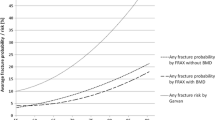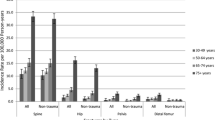Abstract
A case-control study undertaken among members of five Northern California Kaiser Permanente medical centers sought to identify risk factors for foot fractures among persons aged 45 years and older. Foot fracture cases (n=920) and frequency matched controls (n=2366) were interviewed between October 1996 and May 2001 using a standardized questionnaire. Foot fractures occurred most often while walking or climbing stairs. While 60% of foot fractures resulted from falls, 20% were attributed to other causes, such as hitting the foot or tripping on sidewalks and curbs. Having a self-reported history of physician-diagnosed diabetes [adjusted odds ratio (OR)=1.45, 95% confidence interval (CI)=1.10–1.91] or cataracts (OR=1.40, 95% CI=1.07–1.83), having a self-reported foot problem (OR=1.38, 95% CI=1.06–1.78 for two or more foot problem versus no foot problems), having difficulty walking in minimum light (OR=1.86, 95% CI=1.14–3.05) and having had a prior fracture (OR=1.20, 95% CI=1.05–1.37) were associated with increased risk. Putative protective factors for osteoporotic fractures, such as menopausal hormone therapy use, thiazide or water pill use, high calcium intake, and high body mass index were not associated with foot fracture risk. These findings suggest that risk factors for foot fractures among older people differ in part from risk factors for other fracture sites generally considered to be osteoporotic, such as the hip, vertebrae, and forearm.
Similar content being viewed by others
References
Seeley D, Browner W, Nevitt M, Genant H, Scott J, Cummings S (1991) Which fractures are associated with low appendicular bone mass in elderly women? Ann Int Med 115:837–842
Turchin DC, Schemitsch EH, McKee MD, Waddell JP (1999) Do foot injuries significantly affect the functional outcome of multiply injured patients? J Orthop Trauma 13:1–4
Tran T, Thordarson D (2002) Functional outcome of multiply injured patients with associated foot injury. Foot Ankle Int 23:340–343
Hasselman CT, Vogt MT, Stone KL, Cauley JA, Conti SF (2003) Foot and ankle fractures in elderly white women: incidence and risk factors. J Bone Joint Surg [Am] 85A:820–824
Honkanen R, Kroger H, Tuppurainen M, Alhava E, Saarikoski S (1995) Fractures and low axial bone density in perimenopausal women. J Clin Epidemiol 48:881–888
Schwartz AV, Sellmeyer DE, Ensrud KE, Cauley JA, Tabor HK, Schreiner PJ, Jamal SA, Black DM, Cummings SR (2001) Older women with diabetes have an increased risk of fracture: a prospective study. J Clin Endocrinol Metab 86:32–38
Seeley D, Kelsey J, Jergas M, Nevitt M (1996) Predictors of ankle and foot fractures in older women. J Bone Miner Res 11:1347–1355
Ivers RQ. Norton R, Cumming R, Butler M, Campbell AJ (2000) Visual impairment and risk of hip fracture. Am J Epidemiol 152:633–639
Abdelhafiz A, Austin C (2003) Visual factors should be assessed in older people presenting with falls or hip fracture. Age Ageing 32:26–30
Keegan THM, Kelsey J, Sidney S, Quesenberry Jr C (2002) Foot problems as risk factors of fractures. Am J Epidemiol 155:926–931
Keegan THM, Gopalakrishnun G, Sidney S, Quesenberry Jr, CP, Kelsey J (2003) Hormone replacement therapy and risk for foot, distal forearm, proximal humerus, and pelvis fracture. Osteoporos Int 14:469–475
Sidney S, Jacobs DR Jr, Haskell W, Armstrong MA, Dimicco A, Oberman A et al. (1991) Comparison of two methods of assessing physical activity in the coronary artery risk development in young adults (CARDIA) Study. Am J Epidemiol 133:1231–1245
Ainsworth BE (2000) Compendium of physical activities: an update of activity codes and MET intensities. Med Sci Sports Exerc 32:S498--S504
Gomez SL (2002) Methodological issues regarding race, ethnicity and birthplace in epidemiologic research. PhD dissertation, Stanford University
Snellman K (2001) Sports injuries in floorball: a prospective one-year follow-up study. Int J Sports Med 22:501–506
Islam SS, Biswas RS, Nambiar AM, Syamlal G, Velilla AM, Ducatman AM, Doyle EJ (2001) Incidence and risk of work-related fracture injuries: experience of a state-managed workers’ compensation system. J Occup Environ Med 43:140–146
Elgafy H (2000) Fractures of the talus: experience of two level 1 trauma centers. Foot Ankle Int 21:1023–1029
Renstrom AF (1993) Mechanisms, diagnosis, and treatment of running injuries. Instr Course Let 42:225–234
Griffin MR, Ray WA, Fought RL, Melton LJ III (1992) Black-white differences in fracture risk. Am J Epidemiol 136:1378–1385
Wallace C, Reiber G, LeMaster J, Smith D, Sullivan K, Hayes S et al. (2002) Incidence of falls, risk factors for falls and fall-related fractures in individuals with diabetes and a prior foot ulcer. Diabetes Care 25:1983–1986
Visser M, Pluijm SM, Stel VS, Bosscher RJ, Deeg DJ, Longitudinal Aging Study Amsterdam (2002) Physical activity as a determinant of change in mobility performance: the Longitudinal Aging Study Amsterdam. J Am Geriatr Soc 50:1774–1781
LaCroix AZ, Guralnik JM, Berkman LF, Wallace RB, Satterfield S (1993) Maintaining mobility in late life II. Smoking, alcohol consumption, physical activity, and body mass index. Am J Epidemiol 137:858–869
Gerdhem P, Ringsberg KA, Magnusson H, Obrant KJ, Akesson K (2003) Bone mass cannot be predicted by estimations of frailty in elderly ambulatory women. Gerontology 49:168–172
Wells G, Tugwell P, Shea B, Guyatt G, Peterson J, Zytaruk N et al. (2002) Meta-analysis of the efficacy of hrmone replacement therapy in treating and preventing osteoporosis in postmenopausal women. Endocr Rev 23:529–539
Ray WA, Griffin M, Downey W, Melton III LJ (1989) Long term use of thiazide diuretics and risk of hip fracture. Lancet 1:687–690
Stewart A, Jackson R, Ford M, Beaglehole R (1987) Underestimation of relative weight by use of self-reported height and weight. Am J Epidemiol 125:122–126
Kuskowska-Wolk, A, Karlsson P, Stolt M, Rossner S (1989) The predictive validity of body mass index based on self-reported weight and height. Int J Obes 13:441–453
Niedhammer I, Bugel I, Bonenfant S, Goldberg M, Leclerc A (2000) Validity of self-reported weight and height in the French GAZEL cohort. Int J Obes Relat Metab Disord 24:1111–1118
Author information
Authors and Affiliations
Corresponding author
Rights and permissions
About this article
Cite this article
Luetters, C.M., Keegan, T.H.M., Sidney, S. et al. Risk factors for foot fracture among individuals aged 45 years and older. Osteoporos Int 15, 957–963 (2004). https://doi.org/10.1007/s00198-004-1625-2
Received:
Accepted:
Published:
Issue Date:
DOI: https://doi.org/10.1007/s00198-004-1625-2




